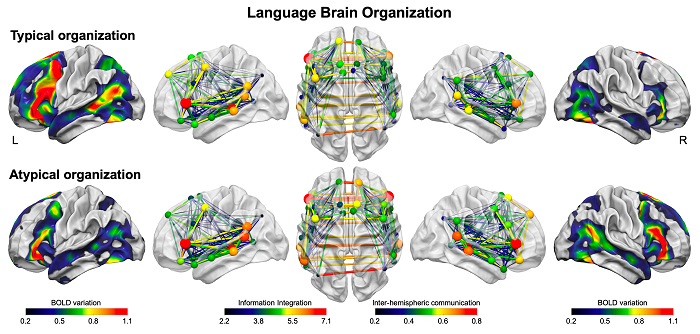The cerebral organization of language, initially described by 19th century neurologists and typically located in the left hemisphere, has not finished revealing all its secrets. In the vast majority of human beings, the left cerebral hemisphere hosts the language processing networks that enable listening, speaking or reading. In some "atypical" individuals, mostly left-handed, language seems to involve the right brain hemisphere. This rare phenomenon has never yet been studied in depth. However, to understand the genetic and environmental determinants of language, it is particularly instructive to describe its cerebral organization in these atypical individuals. Researchers from the Groupe d'Imagerie Neurofonctionnelle (GIN, Bordeaux), who have been working for several years on this important question, lift part of the veil in a study published in the journal eLife.
They analyzed more specifically the network in charge of sentence processing because it brings into play the syntactic and semantic aspects of the language in an integrated way. In order to recruit a sufficient number of "atypical" individuals, the researchers formed a cohort of 287 participants, more than 50% of whom were left-handed. They then combined the use of two functional MRI techniques (fMRI). With activation fMRI, they measured asymmetries in brain activation during the production, listening and reading of sentences. With "resting" fMRI, they recorded spontaneous variations in brain activity in the absence of a task to be performed, in order to measure functional connectivity between regions of the sentence network.
Two types of cerebral language organization were thus identified using a classification algorithm, developed by the researchers, which simultaneously takes into account asymmetries of activation during language tasks, asymmetries of resting connectivity measurements, and the strength of resting connectivity between the two hemispheres. 90% of the participants present a "typical" organization with strong asymmetries in favor of the left hemisphere for the 3 language tasks as well as for the integration of information at rest within the language network. In 10% of the participants, i.e. about 30 individuals, the algorithm revealed a completely "atypical" brain organization of language. It is first characterized by strong right asymmetries during language tasks, while at rest it is characterized by a bilateral integration of information as well as a stronger functional inter-hemispheric connectivity (Figure). Anatomically, the corpus callosum, the thick network of nerve fibers that connects the two cerebral hemispheres, is also larger in atypical participants, which would favour the stronger inter-hemispheric communication observed at the functional level.

Illustration of the
two types of organization, typical and atypical, of language. From left to
right: brain activations of the left hemisphere during sentence production,
integration of information in the resting state of the left hemisphere,
inter-hemispheric communication at rest, integration of information in the
right hemisphere quiescent state and right hemisphere activations during
sentence production.
© Loïc Labache, GIN
IMN, CEA – CNRS – University of Bordeaux.
However, the results also reveal similarities between "typical" and "atypical" brain organizations. In particular, the left-hemisphere language network has a comparable connectivity strength for both types of organization, demonstrating that the two types of organization are not mirrored and that the left-hemisphere organization in language processing is an invariant in the human species.
In this study, the researchers describe an "atypical" organization of language in certain individuals for whom the execution of language tasks requires a strong involvement of the right hemisphere, but also that of the left hemisphere. This work constitutes an important reference point for future fundamental and clinical research studies on language.
News adapted from the Highlight published on the University of Bordeaux's website.
Contact : Bernard Mazoyer, bernard.mazoyer@u-bordeaux.fr
Groupe d'Imagerie Neurofonctionnelle, Intitut des Maladies Neurodégénératives, UMR5293, CEA, CNRS, Université de Bordeaux